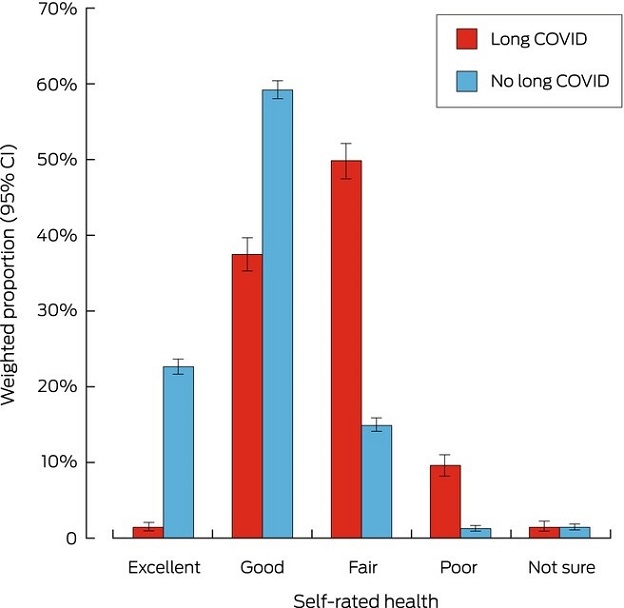Study In A Highly Vaccinated Population Showed That One In Five Australians Still Suffer From Long COVID As A Result Of the Omicron Wave
Nikhil Prasad Fact checked by:Thailand Medical News Team Apr 01, 2024 1 year, 8 months, 6 days, 9 hours, 40 minutes ago
COVID-19 News: The COVID-19 pandemic has not only brought about acute illness but has also highlighted the persistence of long-term symptoms in a significant portion of the infected population. Recent research conducted in Australia sheds light on the prevalence and impact of long COVID in a highly vaccinated population, particularly focusing on the aftermath of the Omicron variant wave.
 One In Five Australians Still Suffer From Long COVID As A Result Of the Omicron Wave. Reported health of adult Western Australian residents who responded to the long COVID survey, 14 October - 1 November 2022, by long COVID status: proportions with 95% confidence intervals. Total numbers of respondents: 2130 with long COVID, 9537 without long COVID.
One In Five Australians Still Suffer From Long COVID As A Result Of the Omicron Wave. Reported health of adult Western Australian residents who responded to the long COVID survey, 14 October - 1 November 2022, by long COVID status: proportions with 95% confidence intervals. Total numbers of respondents: 2130 with long COVID, 9537 without long COVID.
This
COVID-19 News report delves into the findings of this study, highlighting the prevalence of long COVID, its demographic correlations, symptomatology, healthcare utilization, and implications for work or study.
Understanding Long COVID
Long COVID, also known as post-COVID-19 condition, refers to the continuation or development of new symptoms three months after the initial SARS-CoV-2 infection, lasting for at least two months with no other explanation. It encompasses a range of symptoms affecting various bodily systems, including respiratory, neurological, cardiovascular, and gastrointestinal functions.
Study Overview
The study conducted by The Australian National University (ANU) involved over 11,000 Australians who tested positive for COVID-19 during the Omicron wave in 2022. Participants were followed up after 90 days to assess the persistence of symptoms and their impact on health services and daily activities.
Prevalence of Long COVID
The study revealed that almost one in five Australians who contracted COVID-19 during the Omicron wave were still experiencing ongoing symptoms three months after their initial diagnosis. This prevalence rate of 18% underscores the significant burden of long COVID in the population.
Demographic Correlations
The research also identified demographic factors associated with a higher risk of developing long COVID. Women, individuals aged 50 to 69, those with pre-existing health conditions, and individuals with fewer vaccine doses showed a greater susceptibility to long COVID.
Symptomatology
Among the participants experiencing long COVID, fatigue was the most commonly reported symptom, followed by difficulties in concentration or "brain fog," sleep disturbances, and persistent coughing. Notably, a significant proportion of women with long COVID also reported changes in their menstrual cycles, highlighting the diverse nature of long COVID symptoms.
&a
mp;nbsp;
Dr Mulu Woldegiorgis, the lead researcher said the study findings showed that the risk of developing long COVID from the omicron variant is higher than previously thought. He said, "It is more than double the prevalence reported in a review of Australian data from earlier in the pandemic, and higher than similar studies done in the U.K. and Canada. The risk of long COVID was greater for women and people aged 50 to 69, as well as those with pre-existing health conditions and people who'd had fewer vaccine doses."
Healthcare Utilization
The study found that more than a third of individuals with long COVID sought medical care in the month preceding the survey, primarily consulting general practitioners. Hospitalizations related to long COVID were less common but still notable, emphasizing the ongoing healthcare needs of individuals grappling with post-COVID symptoms.
Impact on Work or Study
While most individuals with long COVID were able to return to work or study within a month of their infection, a substantial proportion (18%) reported still not being well enough to do so three months after their diagnosis. This indicates the potential economic and workforce implications of long COVID.
Comparative Analysis
Comparisons with international studies revealed that the prevalence of long COVID in Australia, particularly following the Omicron wave, was higher than previously reported rates. Factors such as vaccination status and the specific virus variant may influence the risk and severity of long COVID.
Implications and Future Directions
The findings of this study have significant implications for healthcare providers and policymakers. They underscore the need for ongoing monitoring and support for individuals with long COVID, especially in terms of healthcare access and occupational accommodations. Further research, including a six-month follow-up survey, is underway to deepen our understanding of long COVID's duration, severity, and potential treatment strategies.
Conclusion
In conclusion, the study conducted in a highly vaccinated Australian population following the Omicron wave highlights the substantial prevalence of long COVID and its impact on healthcare utilization, daily activities, and societal functioning. By elucidating the demographic correlates, symptomatology, and healthcare needs of individuals with long COVID, this research contributes valuable insights to the global effort in managing post-COVID complications and improving patient outcomes.
The study findings were published in the peer reviewed journal: The Medical Journal of Australia.
https://onlinelibrary.wiley.com/doi/10.5694/mja2.52256
For the latest
COVID-19 News, keep on logging to Thailand Medical News.
